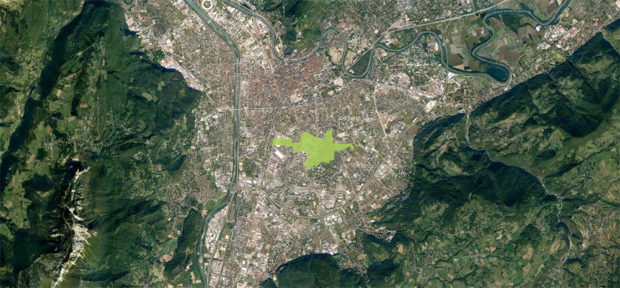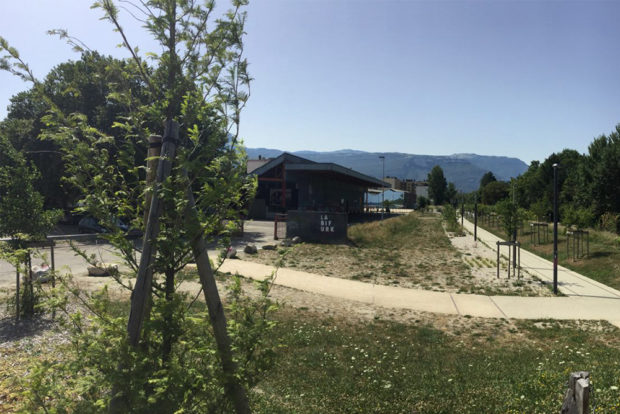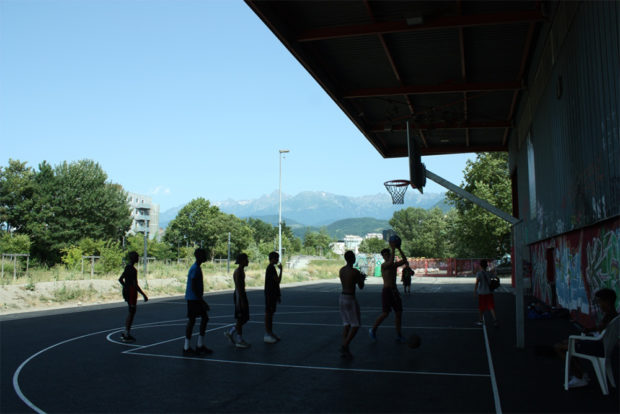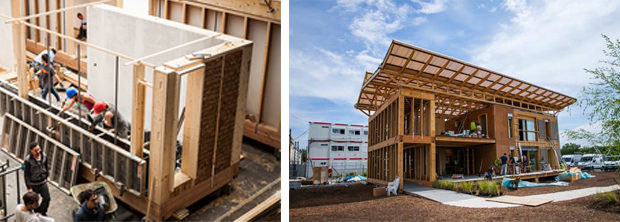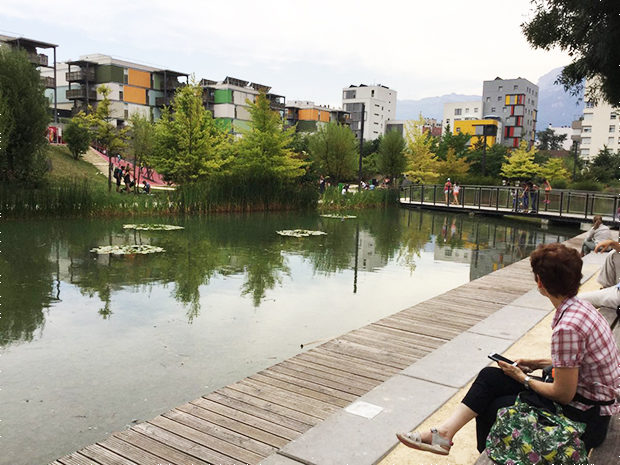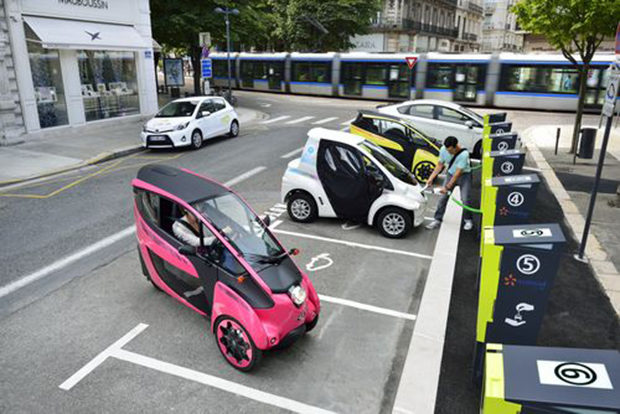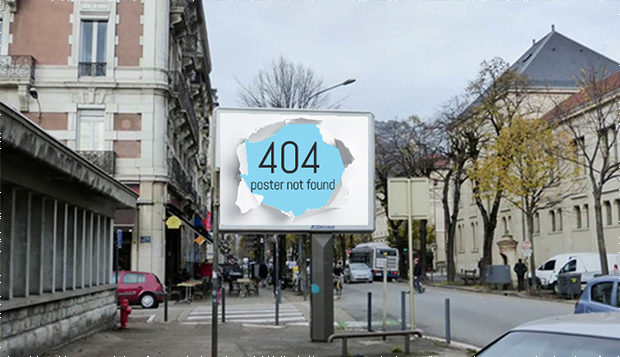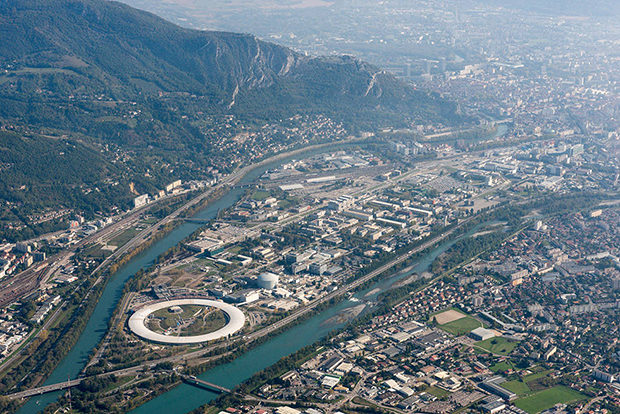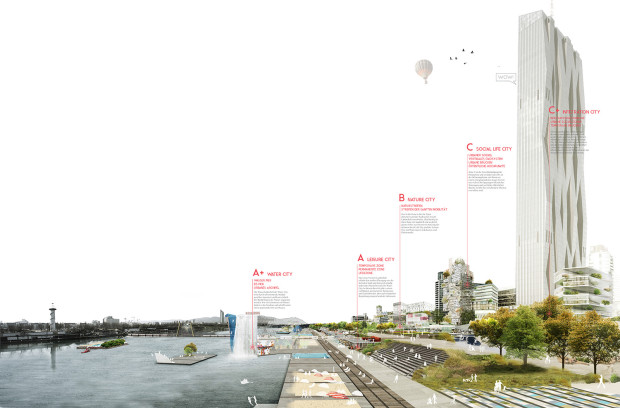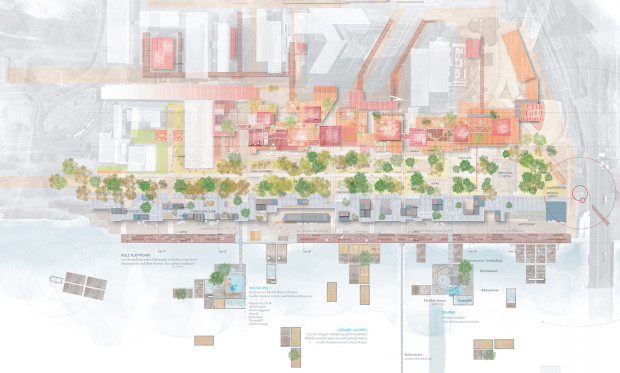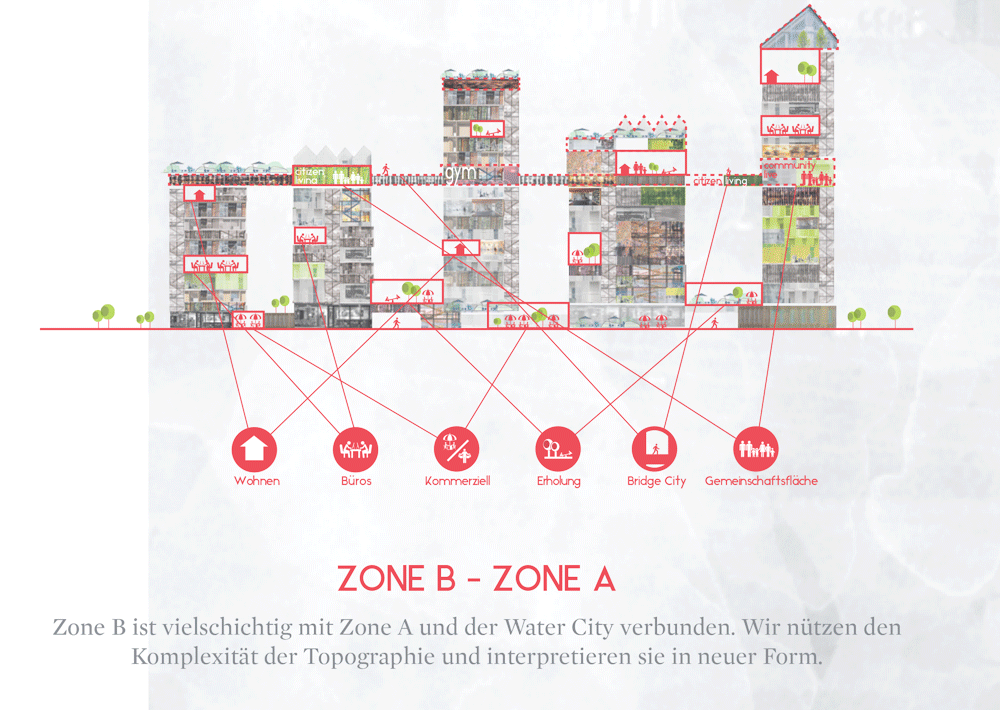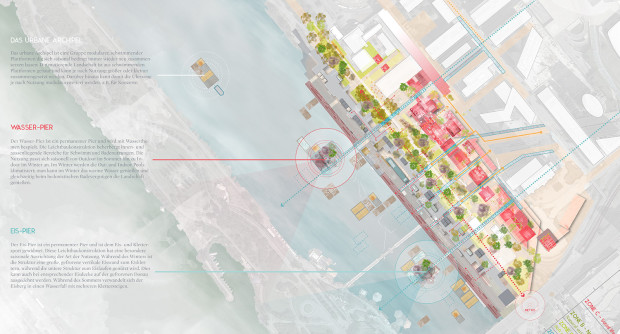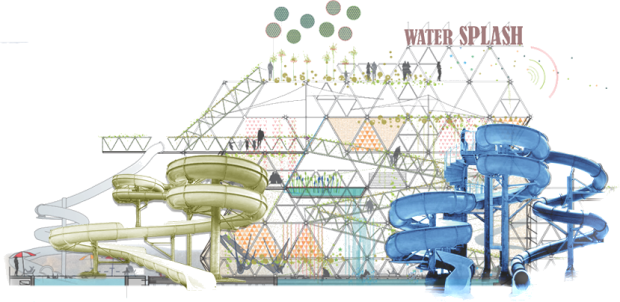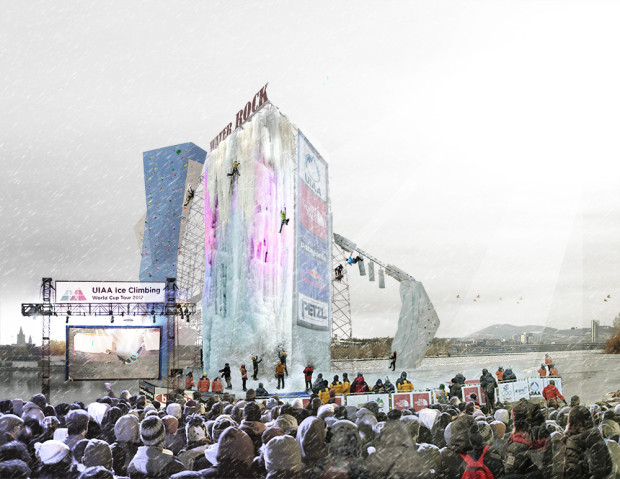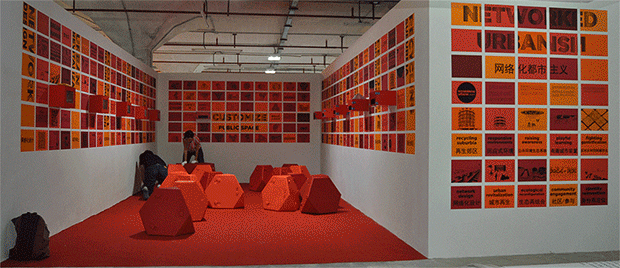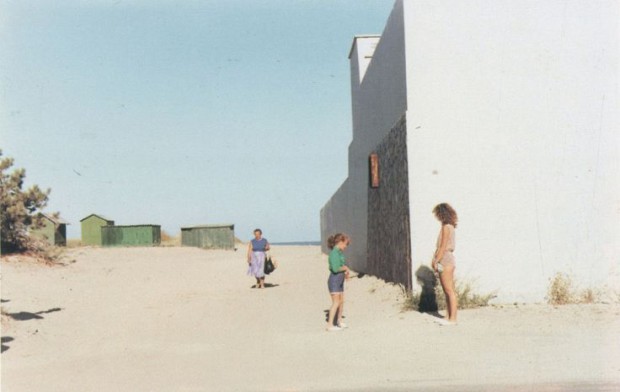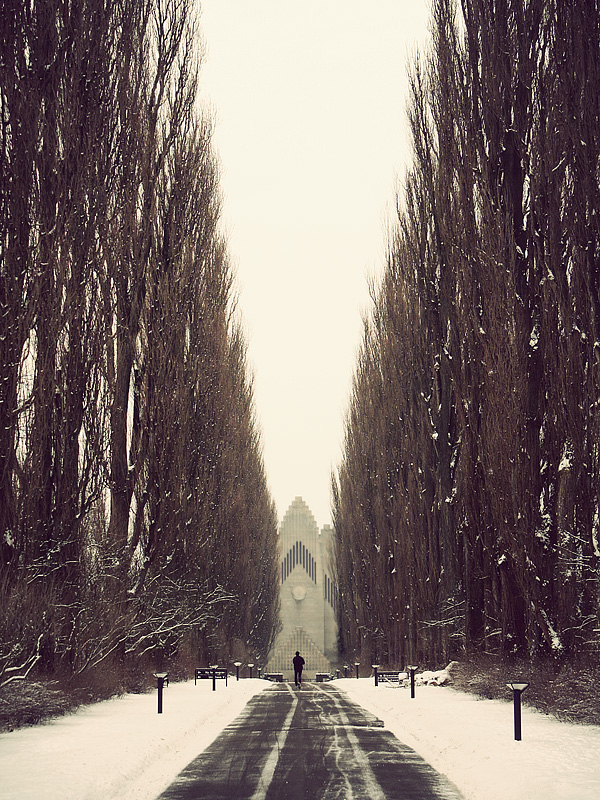A few months ago we ended one of the longest, intense and complex projects our office Ecosistema Urbano has done so far, the Masterplan of the Historic Downtown of Asunción, awarded in an international competition and developed with a multidisciplinary team between Madrid and the Mother of Cities, Asunción.
architecture
October 4, 2016
October 3, 2016
Four years ago Ecosistema Urbano held a workshop in Manama, Bahrain, to revitalize and improve the public space around the Bab al Bahrain souk, an area that is historically important for the city but that it is nowadays a mere street crossing rounded by parking lots, without any tree or shadow. The workshop was held in a remarkable temporary pavilion that for a few weeks converted a roundabout into a vivid and often crowded space, a light textile roof offered shadow and protection to the participants contributing to the success of the workshop. The workshop has been also the occasion for us to start a long term project on Bahrain, under the auspices of the UNESCO Arab Regional Center for World Heritage we started a research project mainly focused on the city of Muharraq, its antique public spaces and how could we revive and improve them. This research has been carried on during 2014 and 2015 spring semesters with the GSD-Harvard students and it emerged immediately that one of the main conditions to make use of the public space in Muharraq was the improvement of the extreme environmental conditions that, combined with a low quality design of the space, prevented and discouraged the people to go out and live the remaining public spaces.

Bab Al Bahrain Workshop 2012
Following this same path of research we are now working on a publication to finally release all the knowledge we have accumulated during these years of work, teaching, and research in the form of a book. Our objective is to address the problems that the designers have to face every time they are called to design a public space in an area with a particularly extreme climate (make it extremely hot, arid, tropical, etc.), we would like to provide decision makers, designers and citizens with a solid base of knowledge to help them consider new technologies and concepts to design public spaces optimized for a certain climate, responding to bio-climatic needs and site specific conditions making it more livable, comfortable and accessible.
Beginning today, we start a series of posts dedicated to the design of bio-climatic public spaces, we will periodically publish part of the content we have produced for the book exposing the problems and the good practices that we have found, our concerns, the work of our students, etc. We would like to foster a debate around these themes that might help us developing our book but also raise the awareness around the climatic comfort in public spaces which is a true challenge for architects and designers in many areas of the world.
continue reading
September 30, 2016
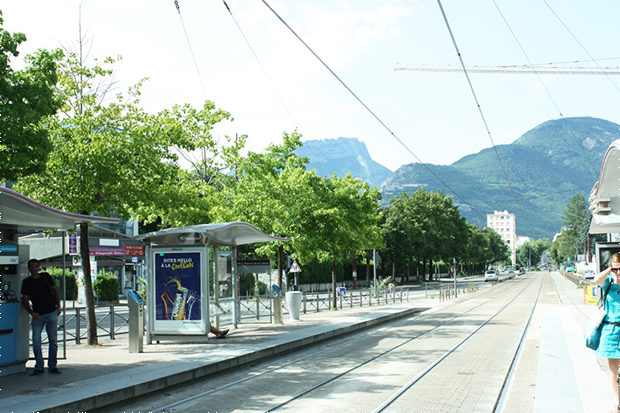
Nous sommes heureux de vous annoncer que nous venons d’être sélectionnés pour le projet d’aménagement de la ZAC Flaubert à Grenoble, une grande et excitante aventure de renouvellement urbain au coeur même de la métropole grenobloise. C´est le résultat de notre collaboration avec Sathy, TN Plus, OGI (ingénierie), Res Publica, et VPEAS.
Il s’agit d’un projet de renouvellement urbain sur un territoire jusqu’alors peu valorisé. La ZAC Flaubert est une zone de transition entre Nord et Sud et entre Est et Ouest de la ville, elle est traversée par de grands axes de circulations qui font de cette ZAC un espace au développement très stratégique. Dû à sa très grande surface (90 hectares) ce projet de grande envergure soulève de multiples enjeux pour la ville et ses habitants. Comment donner une identité à cette zone qui n’est actuellement qu’un assemblage artificiel de micro-identités de quartier ?
Le nouveau maire écologiste désire mettre tout en oeuvre pour intégrer les citoyens à la co-construction de cette zone et plus largement à leur ville. Pour ce projet, il a fait l’engagement de ne jamais cesser le dialogue avec les habitants, les riverains et les commerçants au cours de chacune des phases du projet. Il est également question d’élargir le panel à de nombreux acteurs économiques, institutionnels, académiques de Grenoble grâce à des débats et des discussions. L’objectif est d´échanger les points de vues et les différents avis sur l´avenir de Flaubert.
En juin dernier, lors de notre première visite, nous avons pu mieux comprendre les enjeux du territoire et observer de près la vie urbaine.
Notre objectif actuel est d´étudier en profondeur le projet, pour comprendre à quel point il est complexe et pour nous rendre compte des challenges qui nous attendent.
Un des moments fort de cette visite fût la découverte de la “Bifurk“ et de son “éco-système”, c’est un espace hybride où la vie bat son plein grâce à l’équipe et à de nombreuses associations très actives, qui ont su transformer cet ancien entrepôt industriel en un espace polymorphe où l´on peut trouver une grande diversité d’activités : théâtre, concerts, expositions et même un skatepark. Juste à côté, “La Plage” est la première plage urbaine permanente construite en France. Dédiée à la pratique de sport de sable elle offre au Grenoblois un large choix de sports des plus conventionnels aux plus insolites.
En face de ces lieux emblématiques de la ZAC, il est question d’implanter la casa “Terra Nostra”, une maison en terre et bois construite par les étudiants des écoles d’architecture de Lyon et Grenoble. C’est une occasion de connecter au projet une infrastructure existante, en créant une espace dédié à l´urbanisation de Flaubert à l´intérieur de la maison.
La force de Grenoble est son ouverture d’esprit avant-gardiste : innovante et créative, elle s’inscrit depuis deux décennies dans un programme promouvant une ville plus agréable, plus sociale, plus durable. À l’écoute de ses citoyens et à l’affût des innovations techniques, technologiques, sociales et économique, Grenoble est bien plus que la 11 ème métropole française. Elle est un exemple novateur d’une volonté politique et citoyenne visant à construire autrement la ville de demain. Plusieurs initiatives urbaines et citoyennes singulières ont profondément participé à la mutation de la ville et à sa nouvelle morphologie. Le changement passe par de “grandes actions” mais aussi par de “petites initiatives” qui accumulées donne à la ville une identité propre. La ville soutient chaque année plus de 600 actions qui se regroupent autour de trois grandes lignes directrices : favoriser la participation des habitants, lutter contre toute forme d’inégalités sociales, mettre en avant des territoires les plus fragilisés.
La forte volonté de faire participer les citoyens au renouvellement de Flaubert se place dans la continuité d’une politique ouverte aux propositions de chacun et à l’écoute de ses citoyens. L´intégration de chaque partie prenante au projet permet de recentrer la ville sur ses usagers, de se focaliser sur la ville “à taille humaine”, faite avant tout pour ses habitants. Ce nouveau regard sur la ville et la re-qualification du cadre de vie qu’il engendre participe fortement à l’attractivité territoriale de Grenoble, souvent surnommée la “Capitale des Alpes”. Grenoble est un véritable laboratoire urbain : en 2005, le conseil a adopté un programme de rénovation urbaine soutenant les opérations de renouvellement urbains au sein de la ville en leur accordant un budget très conséquent. Illustrons cette singularité :
Une ville qui réinvente son architecture
La construction d’un des premiers éco-quartiers français dans l’ancienne caserne militaire de Bonne en plein centre ville ( 5 hectares) est un exemple qui concrétise le désir de concilier ville et environnement. Loisos Sava, architecte en chef du projet prône la réinvention de la façon de construire, offrant à la fois une baisse des dépenses énergétiques, une mixité sociale et une mixité fonctionnelle. Cet éco-quartier de nombreuses fois primé a notamment reçu en 2009 le Grand prix national “Ecoquartier” délivré par le ministère de l’Ecologie, de l’Energie, du Développement durable et de la Mer. De plus, très récemment une vaste opération de révision du Plan Local d’Urbanisme intercommunal (PLUi) en 2015 a été opéré. Une des mesures phares de cette révision est la diminution de la hauteur maximale de construction.
Une ville accessible et durable
Grenoble est également une ville pour tous, mettant au centre de ses préocupations l’accueil de tous les publics. En effet elle a été classée première ville de France sur le baromètre de l’accessibilité aux handicaps avec une moyenne de 18,7 et deuxième ville européenne. Grenoble a créé un service d’auto-partage de véhicules électriques appelé “CitéLib” en collaboration avec Toyota qui souhaitait tester ici-même ce système de location unique au monde. Le but est de stimuler la multi-modalité de la ville, en effet ces véhicules 100% électriques servent à incrémenter l’offre de transports publics existants en proposant une solution alternative pour les “premiers et derniers kilomètres”.
Une ville qui s’engage
De plus, Grenoble a su marquer les esprits par une prise de position très forte en 2015. En effet, c’est la première ville européenne à bannir les publicités de ses rues, proposition qui a été soutenu par leur nouveau maire écologiste. La lutte contre la “pollution visuelle” prive la ville d’une manne de revenus importante. Des affichages dédiés aux activités culturelles et aux informations de la mairie remplacent les affichages actuels. De nombreuses autres villes voient en Grenoble un modèle à suivre.
Une ville innovante
Que ce soit au niveau national, européen ou international, Grenoble se démarque par son goût pour l’innovation. En effet Grenoble a reçu de nombreux prix et certifications à toutes les échelles:
National
En 2014, Grenoble a été labellisée “FrenchTech” ainsi que huit autres villes de l’hexagone. Ce label a pour but de donner une meilleure visibilité à l’international de l’attractivité technologique des villes françaises.
Européen
Grenoble a été, en 2014, sacrée deuxième ville la plus innovante d’Europe après Barcelone au concours pour le prix de la première capitale européenne de l’innovation. Ce prix vise à récompenser la ville qui offre le meilleur «écosystème d’innovation» en connectant les citoyens, les organismes publics, les établissements d’enseignement et les entreprises.
Mondial
Cette «iCapitale» a également été cité parmi les 15 villes les plus innovantes par le magazine Forbes en 2013.
Le quartier de la Presqu’île, au Nord de la ville est spécialisé dans les technologies de pointe. Cette Silicon Valley grenobloise est un véritable pôle d’attraction pour le reste de la ville et participe considérablement à sa renommée. La connexion du quartier de la presqu’île à la ZAC Flaubert constituerait une formidable opportunité pour le quartier objet de notre projet qui pourrait donc créer en son sein de nouvelles dynamiques. Ce n’est qu’une des propositions parmi tant d’autres, aucune piste n’est écartée, l’idée étant de procéder par étapes et de se donner un temps d’expérimentation afin d’envisager plusieurs hypothèses éventuelles.
Pour conclure, autant dire qu’en de nombreux points Grenoble sait se renouveler et imposer une nouvelle façon de penser la ville. Ces exemples inspirants et stimulants placent la barre très haut, le défi est grand et nous sommes honorés d’avoir l’opportunité de participer à l’élaboration de ce laboratoire urbain qu’est la ville de Grenoble.

À bientôt pour plus de nouvelles sur ce projet !
September 19, 2016
We are proud to share our success in the competition for the Master Plan for ZAC Flaubert in the city of Grenoble. It is the result of a collaboration with Sathy, TN Plus, OGI (Engineering), Res Publica, and VPEAS. Our candidature has just been selected to lead this great urban transformation and revitalization process in the very center of Grenoble city.
The project deals with the urban transformation of an underused area: ZAC Flaubert. This is currently a 90 hectares transition area at the crossing of a North-South axis and an East-West one, both important for the city. Being a strategic part of the city and its inhabitants, this huge project has various stakes and raises one question: How to give an identity to this area which is now a cluster of micro-identities?
The mayor, from the Ecologist party, wants to integrate citizens in an ambitious co-construction process that would start with Flaubert to spread across the whole city. He is committed to involving residents, shop owners, citizens at each step of the co-construction project. In addition, various other stakeholders are to be involved in the process thanks to different formats such as debates and discussions to exchange points of view and possible visions for Flaubert’s future.
June 10, 2016
Today we are happy to spread this call to Resilience by Design Workshop, organized by the Architecture Sans Frontières Uk, that will take place next september in Nepal.
ASF-UK, in partnership with ASF-Nepal and UN-Habitat are very excited to launch the next installment of Resilience by Design: Nepal 2016 – Reactivating traditional urban settlements through integrated design, planning and building strategies.
If you are a built environment practitioner, researcher or student, join us for a 12 day workshop 10th-23rd September 2016, details below.
Where? Kathmandu, Nepal / When? 10th – 23rd September / Who? Architects, engineers, planners and related built environment practitioners and researchers.
Application deadline: 4th July 2016 / How much? £800 [includes meals, accommodation and travel during the workshop. Flights and airport pick-up not included]
The workshop Resilience by Design Nepal 2016 counts towards Challenging Practice Stage B accreditation.
To apply: Application Form
Contact: resiliencebydesign@asf-uk.org
ASF-UK’s RbD programme, ASF Nepal and UN-Habitat are launching a call for a multidisciplinary* group of volunteers to support the ongoing post-earthquake reconstruction process in Bungamati, a badly-damaged historic town in the Kathmandu Valley with a wealth of traditional architecture, public spaces, heritage and cultural legacies.
During this workshop, volunteers will learn and work alongside the residents and 15 community architects and engineers, by co-designing reactivating strategies for three neighbourhood clusters in Bungamati, focusing on design, planning and building techniques. Each cluster is composed by distinct housing typologies, social and spiritual public spaces, as well as cultural practices. The strategies will then be discussed with the municipality and the different stakeholders involved in the larger reconstruction programme of the Kathmandu Valley.
Join us for 12 days to support an inclusive, safe and sustainable reconstruction process rooted on community empowerment and the safeguard of the heritage and cultural wealth of the Kathmandu Valley.
Resilience by Design 2016 is an initiative by Architecture Sans Frontières UK in partnership with Architecture Sans Frontières Nepal and UN-Habitat, as part of a larger long term reconstruction and recovery collaboration for urban settlements in the Kathmandu Valley.
The workshop is part of RIBA CPD Providers Assessed Material and RIBA CPD Core Curriculum.
VOLUNTEER POSITIONS AVAILABLE IN NEPAL AFTER THE WORKSHOP
We are opening a selection process for 3 Volunteer positions in Nepal available after the workshop, working with ASF Nepal and the RbD team to develop the projects towards implementation. Accommodation and meals will be provided! More info and application process: resiliencebydesign@asf-uk.org
April 26, 2016
Last November we were selected, in collaboration with Transform.city, to participate in the Neue Copa Cagrana International shortlisted competition in Vienna (Austria). The scope of the competition was the urban revitalization and definition of the Master Plan in the area Neue Copa Cagrana defining an urban proposal and the relationship of this part of the city with the river.
We were selected along with other 8 teams, including renowned firms such as Dominique Perrault, AZPML, or West 8.
The context: Donau City, Vienna
The study area is located next to Donau City, on the left bank of the new Danube Canal, Neue Donau, passing through the city of Vienna. It is a neighborhood of mainly tertiary character with office buildings of great height, developed in the last 20 years, including the Vienna International Centre.

Copa Cagrana – the intervention area, between the Danube and the new urban area with the D. Perrault’s tower
Despite the good connection with the city center, the large number of buildings and the excellent existing natural qualities, the area is almost deserted during day and night. This is mainly due to the lack of variety of uses, commercial facilities and recreational areas.
The proposal develops a series of strategies to revitalize an area that already has the optimal conditions to become a landmark for the city of Vienna:
FOUR OBJECTIVES
1 – Increase density and urban mixture
The proposal aims to incorporate urban, commercial and leisure life at a time when Vienna is starting to look for other forms of identity for the river area. It is important to bring new residents to help to create urban activity throughout day and night, summer and winter seasons by permanent and temporary uses. The mixed-use and residential functions in the first row, including the urban boulevard, have the potential to complete and complement the existing urban fabric and establish, for the first time, the necessary connections to make Donau City a functioning and exciting neighbourhood.
The project proposes a high density urban prosthesis, combining housing, office, commercial and public space, in order to create an active urban spot connected to the surrounding, improving its identity and multiplying the possibilities of use.
The proposal seeks to make Donau City easier to be understood and perceived, with a clear connection to Danube river and its waterfront. Therefore, the proposal is the missing link to the completion of the Donaustadt and is, at the same time, the necessary catalyst to enable the urban regeneration in the area.
2 – Create new urban spots
Copa Cagrana will be an exciting new urban spot in Wien, which is perfectly connected to the city network thanks to the transport connectivity and subway line. Through the physical proximity with existing Donau City, Donau Insel and surrounding neighborhoods, the area will increase popularity and will offer more attractions to the users.
The newly created waterfront will be an urban catalyser with a variety of urban functions, with uses according to the seasons and day and night time:
The FILTER ZONE is a more quiet area free of commercial activities.
The TEMPORARY ZONE changes according the different seasons, with beach bars in the summer, pop-up restaurants, terraces and platforms, etc.
The WATERFRONT is an enjoyable walkable strip with piers and exciting water activities for summer and winter.
3 – Renaturing (urban+nature landscape)
A new urban and natural environment intrinsically connected with surrounding nature.
It will be the connecting environment between Donauinsel and Donau Park but also extending its limits over the water landscape of Neue Donau to create a vibrant and diverse waterscape.
4 – Digital Identity – web app strategy
It is important to create the communication channels in order to advertise and share information about the ongoing activities and as a way to share potential ideas to be implemented. This web APP is thought to work as a social network that provides information for the citizens of Copa Cagrana on what kind of activities they can do on this renewed urban area.
Users will be able to register and create a user profile, with this, they will have the opportunity of proposing activities that will make use of the beautiful surroundings and installations of this urban space. The commercial sector will also have their own space. They will have the possibility of creating a profile which will allow them to publicize their products and business, as well as invite and inform citizens about special deals, offers, events and other celebrations.
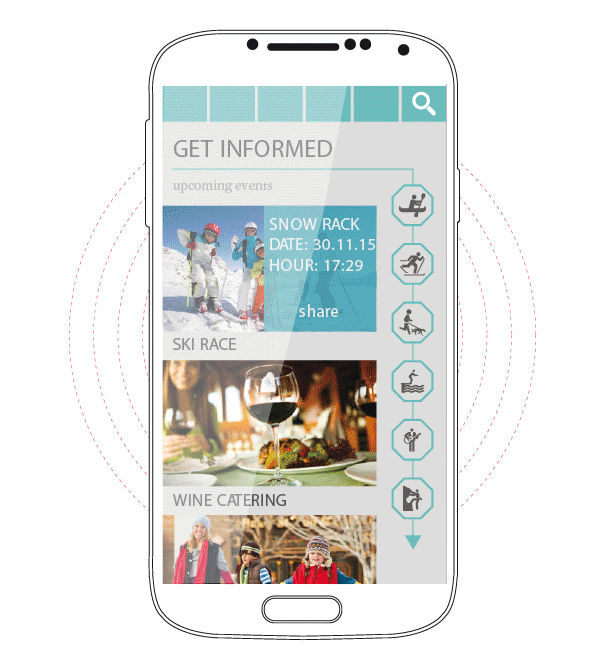
FIVE NEW URBAN ZONES
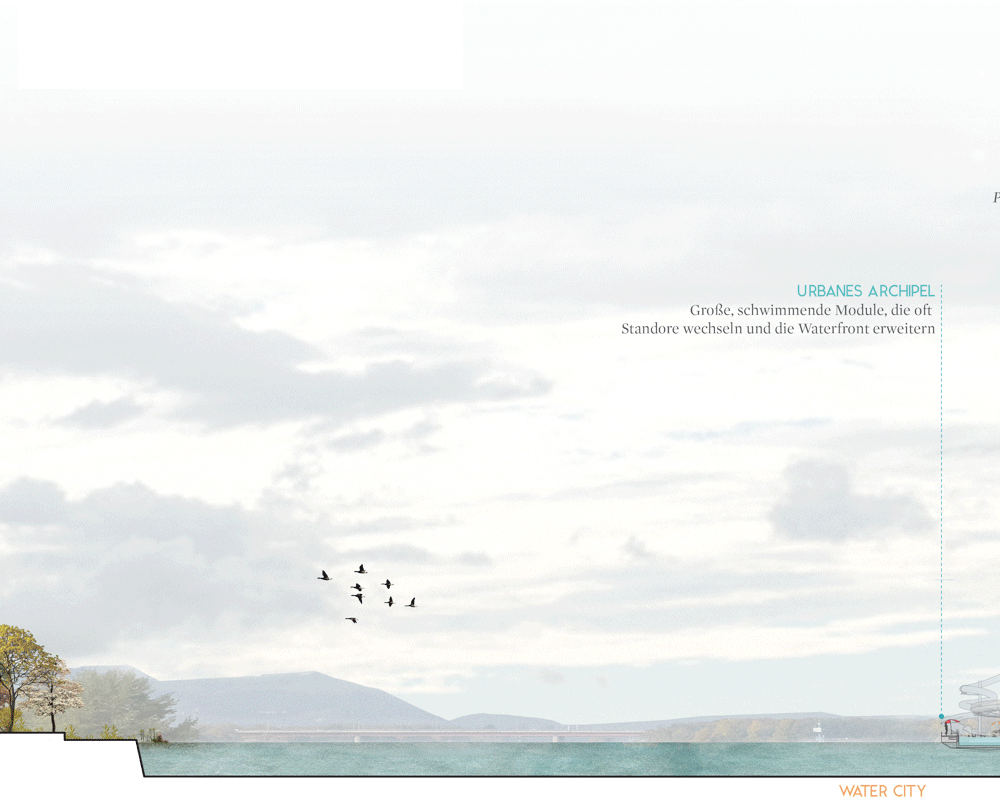
Cross Section
Seeking to achieve these four objectives, the proposal creates 5 zones acting together and related to each other:
Zone C+: Infiltration city
The energy of city life will splash towards Donau City and the urban plinth will extend its limits to bring activity and reconfigure the public spaces around the corporative and residential buildings. These urban tentacles will extend urban plinth limits with linear and small scale pavilions, pop-up stores and cafes, etc. reconnecting and renewing the pedestrian pathways of the Donau city.
Zone C: Social life city
Zone C proposal is the most powerful urban energy boost, as it provides a large amount of overlapped new programs and public spaces easily accessible at different levels.
Areas:
Urban plinth: fragmented construction from 1 to 4 stories high, multiple programs with predominance of commercial spaces overlapped with public spaces at different levels.
Vertical ecosystems: housing towers with a myriad of different typologies to create a diverse neighbourhood. The housing units help to create a dense neighbourhood with urban life throughout the day.
Urban bridge: On the tenth floor, same level as the top terrace of the existing linear building of social housing, a bridge is creating connections between semi public spaces, with diverse programs within the vertical ecosystems.
Public peaks: the top floor of the different towers is also part of the network of semi public spaces within the vertical ecosystems. These spaces can hold multiple programs and part of their success will be the privileged point of view of the city (terraces, cafes, common spaces,… )
Zone B: nature city
This is a zone where nature is predominant and the urban plinth is melting its limits with the landscape. At the same time, the natural character of this area helps to make the transition between the bigger, urban scale of zone C and both the lower scale of zone B and the waterscape towards Donauinsel, combining natural areas with paths for soft mobility.
Zone A: Leisure city
Leisure cityscape to allow the transition between the formal city and the vibrant and ever changing new waterscape of zone C+. It will hold multiple permanent uses but also temporary programs and seasonal activities. There are multiple temporary and permanent uses in small buildings with similar language, as well as a new riverside walk that will extend to create a comfortable linear space. The relationship with water and the elevation difference will be resolved with a wooden platform that will act as an urban sofa to relax and enjoy the presence and proximity of the river.
Zone A+: Water city
Vibrant and ever changing waterscape in continuous evolution. It will extend the activities of the new urban spot towards the water.
+ water pier: permanent pier, water thematic. Light structure with indoor and outdoor spaces to allow the creation of different bathing experiences. The use will change seasonally, during the winter, outdoor and indoor climatized pools will allow the user to be in connection with the surrounding natural landscape while having a pleasant bathing experience.
+ ice pier: permanent pier, ice and climbing sports oriented. Light structure with a strong seasonal connection. During the winter, part of the structure will be a huge frozen and faceted vertical surface to practice ice climbing, while the lower platform will host different ice skating outdoor rinks to practice in connection with the water and natural landscape. During the summer the ice surface is transformed into a huge waterfall falling from the upper level into the river.
+The urban archipelago: big modular and floating ever changing extension of the waterfront. The different seasons and uses will dramatically transform its configuration. This mutant landscape is built with modular floating platforms/barges that can be combined to create larger flat surfaces if necessary. These platforms can be connected to the limit line of the waterfront to extend its surface.
If you want to know more about the proposals you can download the competition panels here:
Panel 1 Panel 2 Panel 3 Panel 4
March 8, 2016
Next friday, Belinda Tato will participate in the Doctor design Conference 2016 lecture, #decoding practice, at the Graduate School of Design, Harvard.
Other speakers include Benjamin H. Bratton, John van Nostrand, Vyjayanthi V. Rao and Antón García Abril, among others.
An extract from the conference brief:
The conference investigates the impact of codes, concerned with mapping of environments, demarcation of legal territories, operational protocols of logistics and risk management, and codes of building and subtraction. By exposing the spatial and socio-cultural implications of micro-politics embedded in the hidden codes and protocols, we speculate about the potential agency of design practices mediating between processes of normalization, and the live, complex, and unpredictable ecologies of human habitation.
Belinda Tato will present ecosistema urbano’s latest projects in Latino America, Russia and Europe.
More info here
#decoding
2016 Doctor of Design Conference
March 11th, 2016
9.30am – 5pm
Stubbins Room
Harvard Graduate School of Design
48 Quincy St., Cambridge, MA, 02138
Conference website: decoding.space
November 18, 2015

⚐ ES – Como ya comentamos anteriormente, desde el pasado mes de Octubre nos hemos incorporado como docentes en el Máster en Arquitectura y Energía (MAE) en la Escuela de Arquitectura y Tecnología UCJC.
El MAE, en su VI edición, profundiza en la nueva suma de conocimientos para la gestión de los recursos, la reducción de la demanda energética y el aprovechamiento de las fuentes renovables en el actual contexto global de crecimiento asimétrico y agotamiento de los recursos, que supone un 40% de la energía consumida en el mundo.
En este contexto, se ha optado por trabajar en una ciudad con una vocación por diminuir su gasto energético como es la ciudad de Encarnación, Paraguay, a través de su Plan de Desarrollo Sustentable en el que llevamos trabajando varios meses. Todos los departamentos del Máster y sus diferentes asignaturas trabajarán en esta ciudad investigando soluciones bioclimáticas para viviendas sostenibles, sistemas constructivos pasivos, un urbanismo en red o fuentes de energía alternativa, con las que encontrar soluciones extrapolables a otras partes del mundo.

⚐ EN – Last October we joined as faculty at the Master in Architecture and Energy (MAE) at the School of Architecture and Technology UCJC.
In the current global context of uneven growth and the depletion of resources, the construction sector accounts for 40 per cent of the energy consumed worldwide. Any work carried out on the land, be it urban, architectural, infrastructural or landscaping, should include strategies for resource management, the reduction of energy demand and the use of renewable sources. The sixth edition of MAE looks in depth at this new body of urgent and essential knowledge, identifying the tools needed to create a development model that is compatible with environmental balance.
We have chosen to work in an emblematic city in terms of energy consumption and new sustainable policies: Encarnación, Paraguay. For the last few months we have been working on the Urban and Territorial Planning and Sustainability Plan for the city, making of Encarnacion a pioneer case study in sustainable urban development.

October 20, 2015
Today we publish an article written by Nathan Romero Muelas, a Spanish architect living in Denmark for more than ten years now. The article has been published in the danish blog arkfo.dk
Immigration is setting Europe in a defensive mode, a state of mind that politically ranges from reluctance to paying lip service to universal solidarity. At the same time, we architects, and not only in Denmark, are busy again with questions of national identity and cultural legacy. Within academia and other architecture institutions, eyes are turning inwards to examine, for instance, all things “Nordic”. There are seminars galore on Nordic urbanism, or for example, on the possibility of a Nordic high-rise.
I’m interested in the timing of these two phenomena. Introspection is important. I guess societies, like human beings, need periodic diving into the oracular “know thyself “ of the Greeks. It usually happens when they feel questioned, or under pressure. I would like to know if this insistence in what we are, (Nordic or whatever), shares this menaced condition.
There have never been so many foreign architects and architecture students, working and living in Denmark. However, how different the situation, the mood, from not yet fifteen years ago, when I first arrived in Denmark. The Europan competition, the Erasmus program: Europe seemed open and enjoying, if I’m not mistaken, a moment of expansive optimism. Today foreigners populate our studios, working as interns mostly, in economic conditions at times worse than their Danish peers. They resemble more the southern immigration of the sixties, a working force that for some threatens the professional establishment, the architectonic version of the very publicised Polish travelling construction workers in Denmark.
COULD THERE BE, I WONDER, A RELATION BETWEEN THIS IMMIGRATION WAVE, MOTIVATED NOT ONLY BY CURIOSITY, BUT ALSO NECESSITY, AND THE URGE OF PROFILING AND BRANDING A NATIONAL OR REGIONAL ARCHITECTURE? BRANDING IN THE COMMERCIAL SENSE (ARCHITECTURE POLITICS) BUT ALSO IN THE ORIGINAL LIVESTOCK SENSE: TO TELL THIS CATTLE FROM THAT CATTLE.
But home is best
In a refreshing essay, (“Drømmen om de smaa samfund”, 1977), Steen Eiler Rasmussen lucidly demolishes the myth of a well functioning small society. He remembers a priest during the German occupation of Denmark. After having spent some time at the Frøslev concentration camp, this priest praised emphatically the experience in the camp. It was a humane experience he wouldn’t have liked to miss: under a common pressure, facing a common enemy, solidarity, mutual care and….a certain cosiness (“hygge”), flourished!
The Biannual competition Europan, with all its limitations and flaws, is a visionary idea, the perfect antidote to nationalist architecture. In the next edition, Denmark has decided not to participate. I imagine there are well founded motives, and surely unrelated to my reasoning here. But let me propose a perverse motive, for argument´s sake: the outcome of Europan is uncontrollable, in principle everybody can win. There follows a compromise, (sadly a weak compromise, in some countries), to build the winning project. Now, let’s say a Chinese architect wins. Frankly folks, what can a Chinese architect possibly know about the arcane secrets of Nordic light? And more importantly: where do we fit this Chinese in the promotion politics of Danish architecture?
Soil, blood and onions
Ever since I arrived to Denmark I have had the unsettling words of the Spanish architect Jose Antonio Coderch at the back of my mind. In 1960 he wrote an essay-manifesto, which was interesting, coming from the most individualist of architects. Its title was It is not geniuses we need know. In it, he wrote: “Let architects work with a rope tied to one leg, to stop them from staying too far from the earth where they have their roots, and the people they know best”. It made then a lot of sense: facing the all pervasive international style, it was a call for attention to the remainder of local building traditions but also hints at the idea that the artist, the architect, should only talk about what he knows well. And that meant then his origin. Despite of his connections to the Smithson’s, his belonging to Team 10 and winning the Milan Triennale golden medal in 1951, Coderch never really left Barcelona. But today I would argue that the exception is an architect that spends his entire life in the place he was born.
I go back to Altea, the Mediterranean town where I was born. I haven’t been here for a long time. Instantly upon arrival, I realize I’m home. That is, my body does. It remembers. The pine trees, the agave, the hills. And, yes, the light, different from any other, and very dear to me. But then I realize that I have spent more time in Copenhagen or Madrid than in Altea, which I left at thirteen. What does it all mean for an architect? Geography, “soil and blood”, I mean. Is it destiny?
I start thinking about notions like Mediterranean, and then Nordic. These are rich, multilayered concepts, and deserving all the scholarly attention they can get…provided we understand that we will not find a single valuable work of architecture that is pure, that isn’t changed, enlivened by the crossing of frontiers. Jacobsen, Aalto, Asplund, Utzon, carry their Mediterranean experience all through their work. Sota, Fisac, Moneo, (who worked for Utzon), were in turn transformed by the Nordic lesson.
I GUESS I’M HINTING AT THE THOUGHT, FRIGHTENING POSSIBILITY, THAT IN AN INCREASING REFINING AND DEFINING OF A NATIONAL OR REGIONAL ARCHITECTURE, NOT JUST ACADEMICALLY BUT IN ORDER TO SELL IT, EXPORT IT, PROMOTE IT, BE IT BALKAN, TEUTONIC, MEDITERRANEAN, SOUTHERN OR NORDIC, WE MIGHT END UP WITH SOMETHING RATHER STERILE, OR ILL VENTILATED: IN SEARCH OF THE QUINTESSENTIAL IDENTITY, WE MIGHT FIND…REDNECK ARCHITECTURE.
Because despite my beloved Coderch and today’s pushers of national architectures, architects do choose now the soil they live and work on. Unlike onions.


